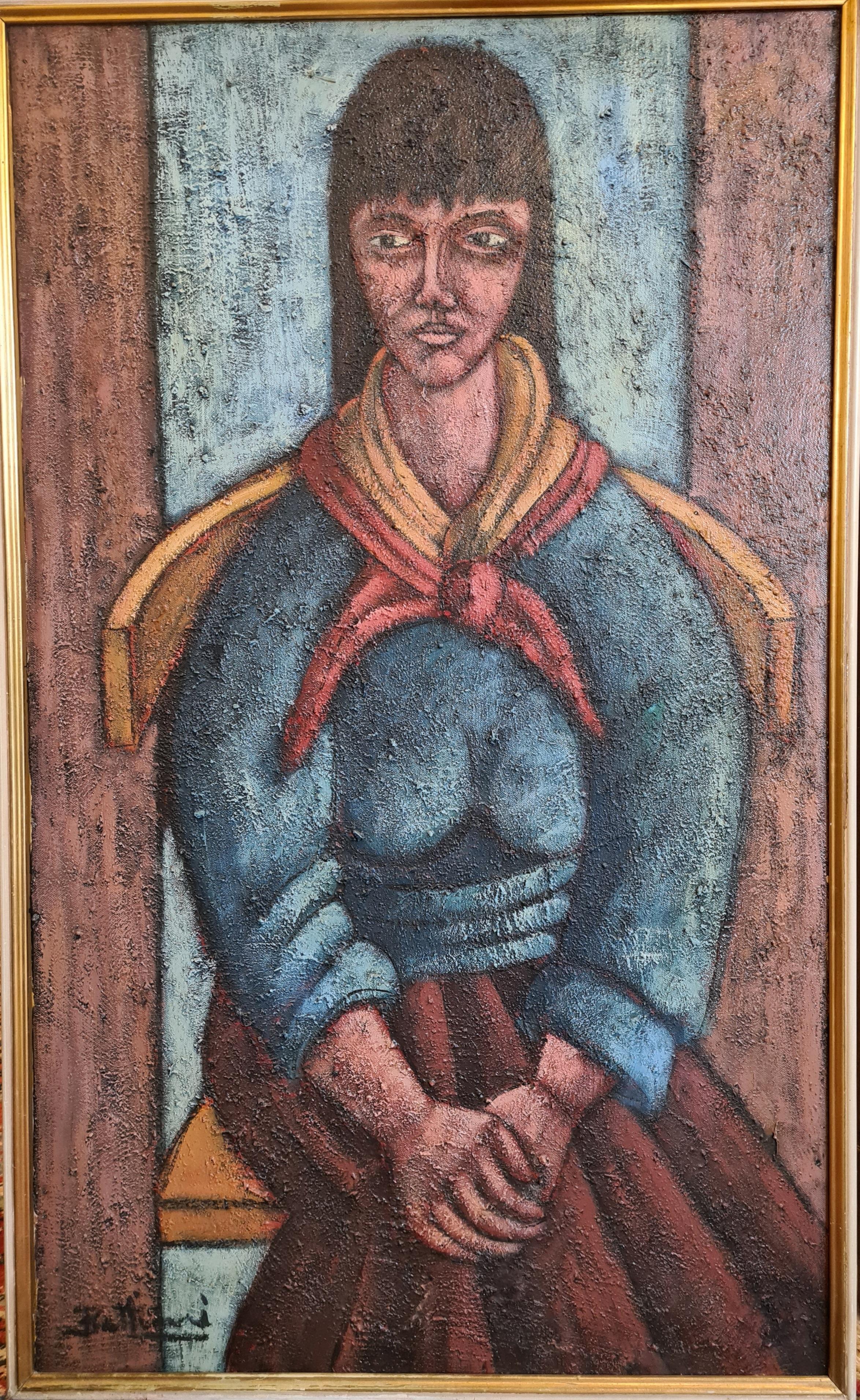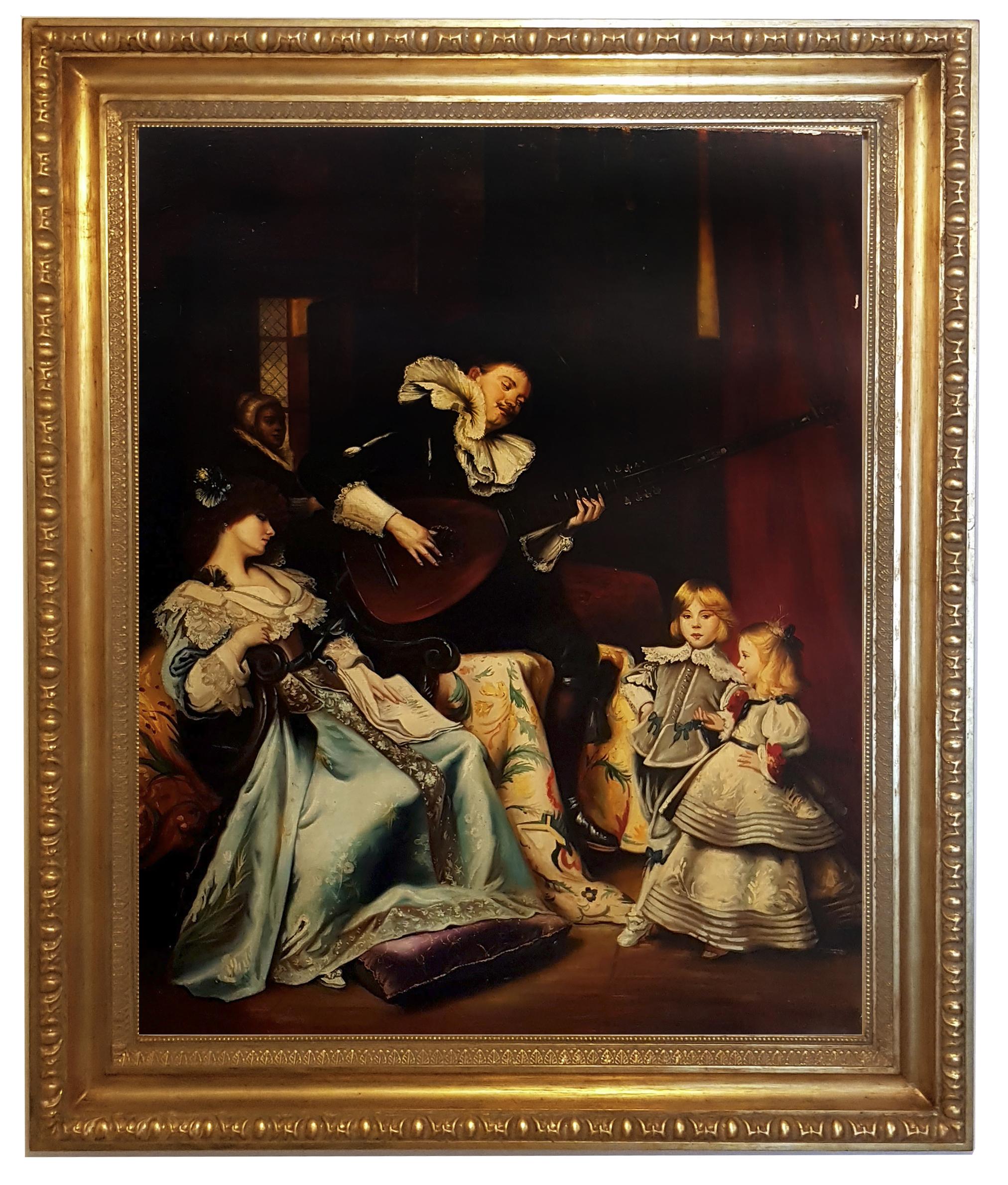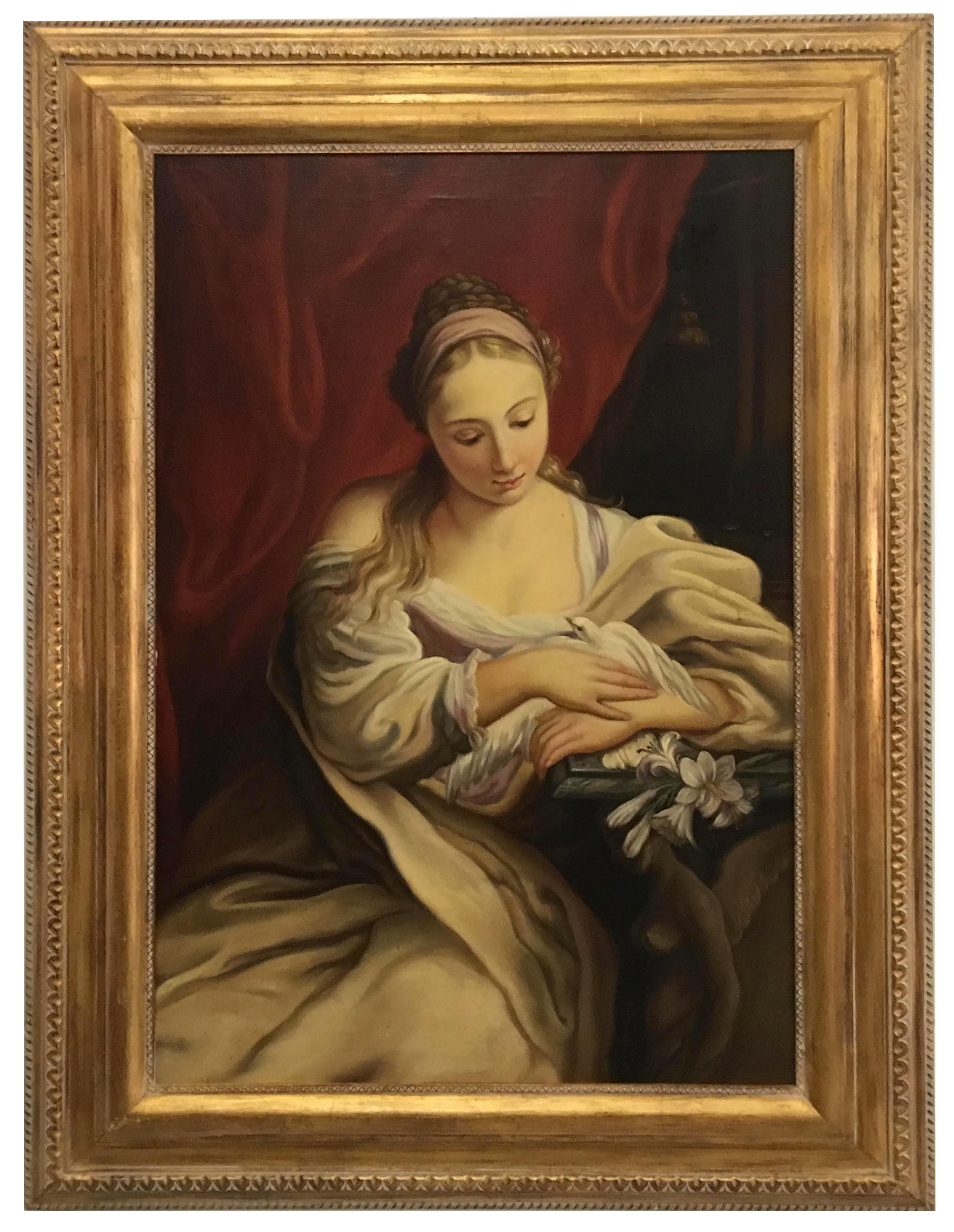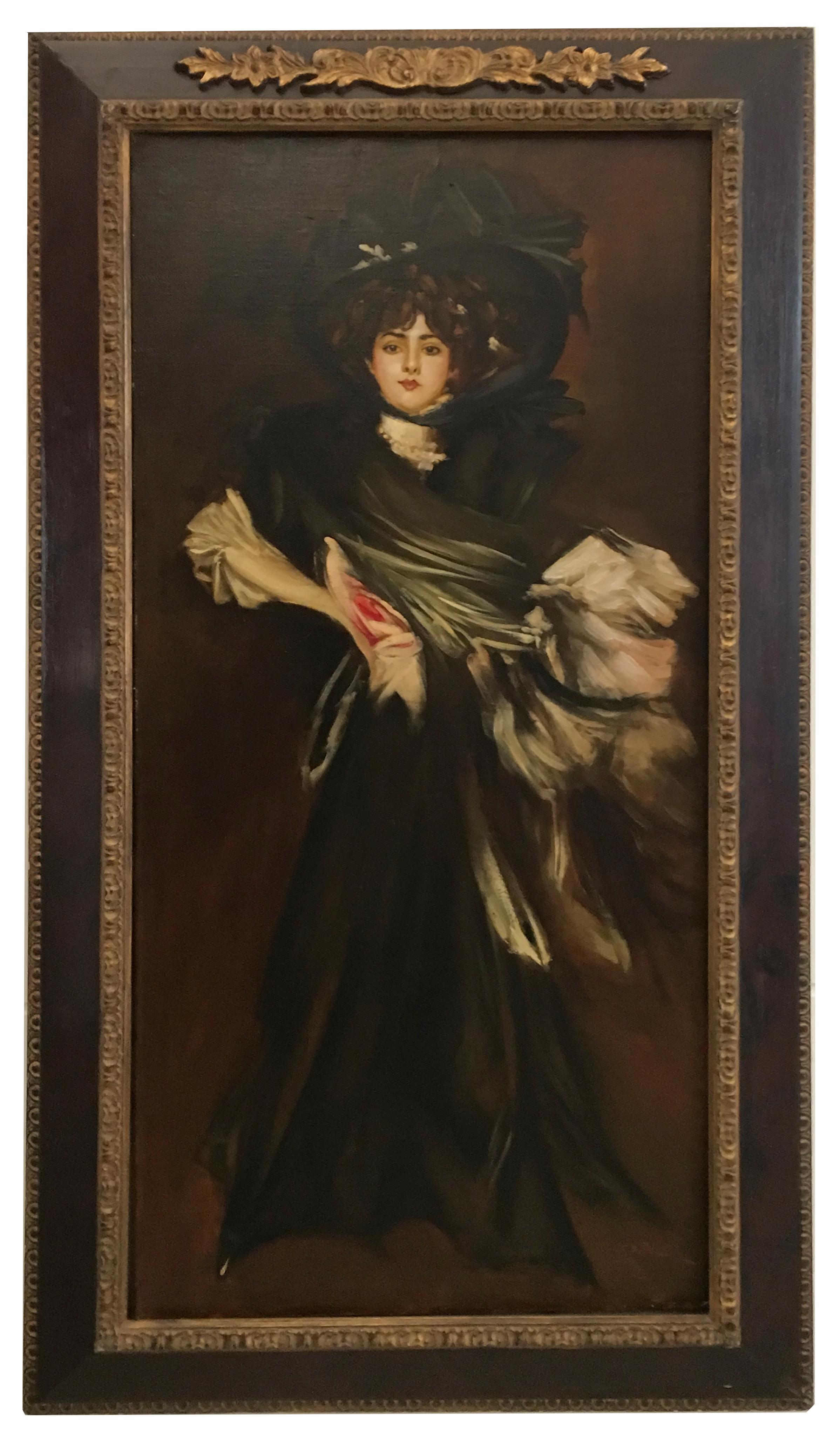Items Similar to Attilio Manganaro (c.1865-c.1890) - Portrait of Gabriele d’Annunzio in 1887
Want more images or videos?
Request additional images or videos from the seller
1 of 9
Attilio ManganaroAttilio Manganaro (c.1865-c.1890) - Portrait of Gabriele d’Annunzio in 18871887
1887
About the Item
Attilio MANGANARO
(c.1865 – c.1890)
Portrait of Gabriele d'Annunzio in 1887
Oil on canvas
H. 52 cm; L. 42 cm
Signed and dated lower right 1887
On the frame an inscription in Italian indicating that the painting was painted at the time of the book "L'Armata d'Italia" by d'Annunzio, 1887-1888
Our portrait is an extremely rare original artistic iconography by Gabriele d'Annunzio (1863, Pescara – 1938, Gardone Riviera) perhaps the earliest known to date.
We have a photograph of d'Annunzio as a teenager (the poet gave a dedicated version to the actress Cécile Sorel), and another of him as a young man, without a mustache and with rather abundant hair, probably dating from a shortly before (a few years?) our painting. Another photograph represents him a priori at the age of 25, in 1888; this photo serves as the basis for an illustration published in particular in “L’Illustrazione Italiana” in August 1889; he then has a mustache with the ends smoothed and raised, and a hairstyle already a little less provided. A photograph by his friend the painter Francesco Paolo Michetti (1851-1929) shows him on the beach at Francavilla, getting out of the bath, with a somewhat messy mustache but resembling that of the previous photo, at the age of 25 years (photo taken in September 1888).
Concerning the original works of art (drawing, painting, sculpture), it is the bust executed by Paul Troubetzboy (1866-1938) which seems, apart from ours, to be the first effigy of d'Annunzio; the Russian artist came to Naples in 1891 to create a monument to the glory of Garibaldi, and he met d'Annunzio there who stayed there between the end of 1891 and the end of 1893, the two artists forging a long-term friendship there . On this bust, datable to 1892, the Italian poet now wears a pointed goatee, in addition to his raised mustaches.
In 1895, d'Annunzio was portrayed by Michetti; in addition to several photos taken in the painter's studio, there is a drawing (40 x 30 cm) in charcoal, where he always appears with a raised goatee and mustache, but also with the onset of pronounced baldness.
However, it is possible that Michetti made other portraits of d'Annunzio, their friendship dating back to the early 1880s. de Pescara), in the Franciscan convent of Santa Maria del Gesu, which Michetta bought in 1885.
At the time of our portrait, d'Annunzio was living in Rome, where he came to complete his studies from November 1881. He had already published collections of poems: Primo Vere in 1879, Canto Novo in 1882, collections of short stories (The Book of Virgins in 1884 and Saint Pantaléon in 1886), which earned him a certain notoriety, particularly in aristocratic and intellectual circles. He had an intense social activity, and became a contributor to the newspaper "La Tribuna" (founded by Prince Maffeo Barberini Colonna di Sciarra) at the end of 1884, in which he often wrote under the pseudonym of "Duca Minimo". Important salon character, brilliant journalist, he also has the reputation of an irresistible seducer, even if he has been married since 1883, and 1887 also marks the beginning of an affair with Barbara Léoni which will last five years.
In September 1887, he took a cruise on the Adriatic aboard the yacht of his friend Adolfo de Bosis, a cruise that turned into a mishap following which the passengers were rescued by a Navy battleship. Interviews with the officers of the battleship lead d'Annunzio to delve into the problems of the Italian Navy, and he then writes a series of controversial articles (the recipient is Admiral and Minister Benedetto Brin), heroic in tone and nationalist, in which he asks for the reinforcement and a better organization of the Italian fleet (the Armata). These political articles will be published in "La Tribuna" from May 27 to July 6, 1888 and then published the same year under the title "L'Armata d'Italia", one of the least known works of the Italian poet today.
It was probably in this journalistic and nationalist context that d'Annunzio met the author of his portrait, Attilio Manganaro.
Of this artist we know very little. He is the son of the famous nationalist painter, illustrator and caricaturist Antonio Francesco Paolo Manganaro (1840, Manfredonia – 1931, Naples). The latter, a great patriot and lover of freedom, was one of the members of the secret action committee of 1859 and actively participated in the revolutionary uprisings of 1860 against the Bourbons, where he distinguished himself alongside Garibaldi by his bravery and his audacity. Subsequently he was hired as a caricaturist by Alessandroni, editor of the newspaper "L'Arche de Noé". Considered one of the main caricaturists of the time with Errico Colonna and Melchiorre Delfico, he obtained in 1885 the chair of drawing at the technical school "Giambattista della Porta" in Naples.
Antonio Manganaro had two sons, Alberto and Attilio, both painters, who died very young, and were close like their father to nationalist circles linked to the Risorgimento. Attilio is moreover described, in the epitaph on his father's tombstone, as a "genius of painting", which the almost total ignorance of his corpus does not allow us to judge. We do know, however, that Attilio was also an illustrator for the press and that he worked for the humorous weekly "Il bello Gaspare" (founded in Naples in 1878), alongside other nationalist artists such as Edoardo Matania (1847-1929 ) and Gennaro Amato.
It was therefore at a pivotal period in d'Annunzio's career, where he was certainly known, but just before the fame that the publication of his first novel Il piacere (The child of pleasure in French) would bring him in 1889, what is done this portrait all in intimacy and half-light, testimony of an artistic encounter in the Roman nationalist circles of the 1880s.
- Creator:Attilio Manganaro (1865 - 1890, Italian)
- Creation Year:1887
- Dimensions:Height: 20.48 in (52 cm)Width: 16.54 in (42 cm)
- Medium:
- Movement & Style:
- Period:
- Condition:Perfect condition. Cleaned.
- Gallery Location:BELEYMAS, FR
- Reference Number:1stDibs: LU186029879242
About the Seller
No Reviews Yet
Vetted Seller
These experienced sellers undergo a comprehensive evaluation by our team of in-house experts.
Established in 2011
1stDibs seller since 2022
- ShippingRetrieving quote...Ships From: BELEYMAS, France
- Return PolicyThis item cannot be returned.
More From This SellerView All
- Men portraitBy Giovanni Maria delle Piane dit Mulinaretto (Genoa 1670 - Monticelli d´Ongina 1745)Located in BELEYMAS, FRGiovanni Maria DELLE PIANE, known as IL MULINARETTO (Genoa, 1660 – Monticelli d'Ongina, 1745) Portrait of a man Oil on oval canvas H. 108 cm; L. 83 cm Provenance: Nino Ferrari Colle...Category
1730s Italian School Figurative Paintings
MaterialsCanvas, Oil
- French King Louis-Philippe - After Baron GérardLocated in BELEYMAS, FRAfter Baron Gérard, circa 1835 Portrait of King Louis-Philippe Oil on canvas H. 79 cm; L. 65 cm Provenance : Private collection, Périgord, by descent since the 19th century This po...Category
1830s French School Figurative Paintings
MaterialsCanvas, Oil
- Women portrait (Coraline)Located in BELEYMAS, FRAuguste Adolphe CHAUVIN (Liege, 1810 – Liege 1884) Portrait of Coraline Oil on canvas Signed and dated lower right 91 x 68 cm 1868 Auguste Adolphe Chauvin, born in Liège on October ...Category
1860s French School Figurative Paintings
MaterialsCanvas, Oil
- Four large family portraitsLocated in BELEYMAS, FRSuite of four large family portraits, kept together to this day. Created around 1840 by the painter Théophile Morel, who presented portraits at the Salon des Artistes Français from t...Category
1840s French School Figurative Paintings
MaterialsOil, Canvas
- François-Joseph Kinson - Young woman portrait with her dogBy Francois Kinsoen (Kinson)Located in BELEYMAS, FRFrançois-Joseph KINSON (Bruges 1770 – Bruges 1839) Portrait of a young woman near a spring, accompanied by her dog Oil on canvas H. 73 cm; L. 60 cm circa 1815-1817 We owe this elegant portrait to François-Joseph Kinson from Bruges, which is still linked to the art of the First Empire. We find in this artist this type of pose that is a bit rigid, sometimes with a countryside in the background, and this way of treating costumes and faces. Thus the full-length portrait of Jenny...Category
1810s French School Figurative Paintings
MaterialsCanvas, Oil
- Young girl readingLocated in BELEYMAS, FRAlice BASTIDE (Saint Mandé 1868 – Paris 1959) Portrait of a little girl reading Oil on canvas H. 100 cm; L. 72.5 cm Signed lower right and dated 1912 Daughter of a pastor from Gard and an English woman, Alice Bastide grew up in Paris. A pupil of the Jullian Academy, she began her apprenticeship under the guidance of Henri Royer and François Schommer. The development of his art is mainly oriented towards still lifes, without completely abandoning portraits and landscapes. Her other specialty for which she received numerous awards is miniatures. At the Salon of 1914 she received the Maxime David prize crowning the best piece while her finesse was already noticed by press critics from 1907. Coronation, in 1926 she received a gold medal at the Salon for her miniature Coquetterie. In 1896, the young woman married a man from Gard, Auguste Massebiaux, whose name she would occasionally bear. The latter, a lawyer at the Paris Court of Appeal, died in 1910. The couple had no children. At that time she was domiciled at 48 avenue d'Orléans (later named avenue du general Leclerc) in Paris where she lived until her death in 1959. Until the mid-1930s she continued to exhibit at the Salon des Artistes French with a manner very close to Impressionism, luminous and vigorous. In 1912, two years after the death of her husband, Alice Bastide was certainly still marked by the sadness of her mourning. The tones of our portrait of a little girl and the frame she puts together are dark and heavy. This child, wearing an embroidered bonnet, is bent over her book, her loose hair flowing over a red velvet indoor dress. This intimate portrait on a dark tapestry...Category
1910s French School Figurative Paintings
MaterialsOil, Canvas
You May Also Like
- Woman Seated in a Klismos Chair. Italian School, Transavantgarde Oil on Canvas.Located in Cotignac, FRMid 20th Century Italian portrait of a seated lady signed Battionni bottom left. Presented in a white and gilt wood frame. A characterful stylised...Category
Mid-20th Century Italian School Figurative Paintings
MaterialsCanvas, Oil
- SCENE WITH MINSTREL- Eugenio De Blasi - Italy -Oil on canvas paintingBy Eugenio De BlasiLocated in Napoli, ITScene with Minstrel - Oil on canvas painting, Eugenio De Blasi, Italy, 2005 This is his reinterpretation of a greatest old master painting by Giovanni Boldini.Category
Early 2000s Italian School Figurative Paintings
MaterialsCanvas, Oil
- PORTRAIT OF YOUNG WOMAN - Venetian School -Italian oil on canvas paintingBy Eugenio De BlasiLocated in Napoli, ITPORTRAIT OF YOUNG WOMAN - Oil on canvas painting cm.95x65, Eugenio De Blasi, Italy, 2008 The painting by Eugenio De Blasi is inspired by the work of the Venetian painter and portrai...Category
Early 2000s Italian School Figurative Paintings
MaterialsCanvas, Oil
- LADY IN BLACK-In the Manner of G. Bodini Italy figurative oil on canvas paintingBy Eugenio De BlasiLocated in Napoli, ITLADY IN BLACK - Oil on canvas painting, Eugenio De Blasi, Italy, 2011 This is his reinterpretation of a greatest old master painting by Giovanni Boldini. Gold leaf gilded and mohogan...Category
Early 2000s Italian School Figurative Paintings
MaterialsOil, Canvas
- AUTUMN'S ALLEGORY - Eugenio De Blasi - Italian Portrait Italian Oil on CanvasBy Eugenio De BlasiLocated in Napoli, ITAutumn's Allegory - Oil on canvas cm.60x50, Italia, 2007, Eugenio De Blasi (3c59a) The painting by Eugenio De Blasi is an autumn allegory inspired by the allegorical figures of the ...Category
Early 2000s Italian School Portrait Paintings
MaterialsCanvas, Oil
- LADY'S PORTRAIT - Venetian School - Oil on Canvas Italian Figurative PaintingBy Giovanni SantanielloLocated in Napoli, ITLady's portrait - Giovanni Santaniello Italia 2002 - Oil on canvas cm. 100 x 80 The painting by Giovanni Santaniello depicts a portrait of a beautiful pensive woman in elegant clothe...Category
Early 2000s Italian School Portrait Paintings
MaterialsOil, Canvas
Recently Viewed
View AllMore Ways To Browse
Bourbon Art
Russian Man Portrait
Portrait Of A Russian Man
Painting Of Santa Maria
Painting Of French Riviera
Effigy Art
Antique Navy Paint
Italy Cruise
Paolo C
Antique School Chairs
Antique School Chair Chairs
Antique School Chair
French Riviera Painting
Antique Chair Drawing
French Painted Period Chair
Effigy Sculpture
Antique Rescue
Prince Chair





